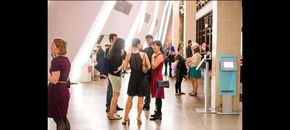Contemporary Jewish Museum
Since its founding in 1984, the Contemporary Jewish Museum has engaged audiences of all ages and backgrounds through dynamic exhibitions and programs that explore contemporary perspectives on Jewish culture, history, art, and ideas. Throughout its history, the Museum has distinguished itself as a welcoming place where visitors can connect with one another through dialogue and shared experiences with the arts.
In 1990, the success of the Museum prompted its leadership to plan for a more expansive facility to meet the growing interest of the local community. The Museum began formally exploring real estate options when the San Francisco Redevelopment Agency (1994-1995) invited the Museum to develop the historic Jessie Street Pacific Gas & Electric (PG&E) Power Substation, a 1907 landmark designed by architect Willis Polk, who remains extremely.
In 1998, the Museum selected architect Daniel Libeskind to design its new home. Envisioned as a dynamic and welcoming space, the new 63,000-square-foot facility was planned to be a place to experience art, music, film, literature, debate, and — most importantly — other people. Daniel Libeskind's design for the Museum does not simply house this programmatic vision; it enables and inspires it.
Embracing a range of artistic disciplines and media, the Museum’s exhibition program includes contemporary art and historical objects, film and music, conversations, lectures, literary readings, and other live performance. Dynamic and ever-changing, the Contemporary Jewish Museum is a non-collecting institution that partners with national and international cultural institutions to present exhibitions that are both timely and relevant and that represent the highest level of artistic achievement and scholarship. At the heart of our programs is a focus on education and outreach to the broader community with the goal of fostering interfaith and intercultural dialogues.
The Museum officially opened the doors to its new building on June 8, 2008 with a community-wide celebration.
Ongoing Exhibitions
Lamp of the Covenant: Dave Lane
The Contemporary Jewish Museum (The CJM) unveils a new commissioned artwork by Sacramento-based artist Dave Lane in its soaring lobby space. The massive sculpture, entitled Lamp of the Covenant, is a 90-foot-long, six ton work suspended high over the heads of visitors. Attached to an enormous oval of steel are antique objects: world globes, light bulbs, tools such as nineteenth century apple peelers and blow torches, and various other objects that suggest the unfolding marvels of the cosmos.
Hardly Strictly Warren Hellman
The Contemporary Jewish Museum celebrates the legacy of one of San Francisco's greatest and most beloved benefactors in a new exhibition Hardly Strictly Warren Hellman. Warren Hellman (1934-2011) was an investment banker, philanthropist, musician, and music enthusiast who believed in the importance of community arts. Among a host of business and philanthropic accomplishments, Hellman may now be best recognized for the Hardly Strictly Bluegrass Festival (HSB), which he founded in 2001. Held annually in Golden Gate Park, the free festival draws more than 700,000 people.
Pour Crever by Trimpin
Trimpin is a MacArthur "genius" award-winning sculptor who has lived in Seattle for decades. His work—unusually accessible for general audiences— usually involves sound installations triggered by computer controls. In this work a tank of water at fourteen feet is suspended over an identical tank of water. A special mechanism developed by the artist releases drops of water in the shape of letters of the alphabet. For this work, the water drops will spell out the last names of the deported residents of his region; they fall through space and then disappear forever into the second tank of water. The title is a quote from the great Jewish philosopher Hannah Arendt, who, when asked why she was sent to Gurs, responded that she was sent to Gurs "to suffer and die miserably, (pour crever)."
read more
show less



